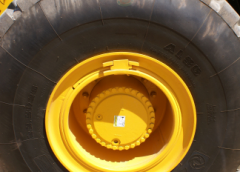In today’s budget-conscious environment, fleet managers are under ever increasing pressure to maximize the life span of their costly OTR tires and are simultaneously being tasked with minimizing fleet down time. Being able to repair these tires quickly and efficiently is a key challenge.
OTR tires are used under extreme conditions experiencing a greater load and higher flex than tires used elsewhere meaning a robust repair process, such as a hot cure, is required.
Monaflex is often asked whether there is any special process for super-sized repairs. They offer the following top tips:
- Always remain within manufacturer guidelines for consumable repairs. Determine whether the repair is possible by referring to the dimensions provided in the manufacturer’s guidelines and do not exceed their recommendation.
- Use accurate pressure for a perfect repair. Pressure needs to be applied accurately to ensure that the repair conforms completely to the complex profile of the tire and produces a distortion free, feather edged repair.
- Dual heat sources lead to faster repairs. The use of simultaneous internal and external heat sources, allows for rapid transfer of heat through the repair and simultaneous curing of the patch and the plug – both leading to a significantly reduced cure time.
- Make sure your repair system can handle the size. Many maintenance teams are forced to undertake multiple cures to repair large injuries – a time consuming approach. By using a Heat Pad of sufficient surface area, such as one of Monaflex’s, you can cover and vulcanize injury sizes far greater than any other, in one cure.
- Be meticulous when preparing your repair area. To avoid contamination, cleanliness is vital at all stages. Ensure that the repair area is thoroughly scraped clean with cleaning fluid before and after preparation for the patch and skive plug installation. Always follow the Rubber Manufacturers Association (RMA) specifications when buffing. Equally, be thorough when you brush and vacuum the repair area.
- Let any cement used dry properly. Make sure cement dries completely before stitching the gum or patch down. This prevents wet cement “gassing off” during the curing process, which could compromise the repair and cause failure.
- Using the repaired tire in the correct way. Thisis even more important for the largest injuries. Check company guidelines and always mount repaired tires at the rear of the vehicle to minimize stress.
Monitor tire pressure and temperatures during use with a TPMS system and make sure manufacturer guidelines are followed.
Do not overload the vehicle past the recommended parameters as this causes undue wear to the tires (and any repairs).
Important: Please consult and adhere to all company guidelines as well as tire and tire repair manufacturers’ guidelines and recommendations when undertaking repairs.
Monaflex is a leader in the repair and vulcanization of damage in all tires, from the largest OTR earthmovers to the smallest truck. You can find out more by visiting monaflex.com or contacting them at [email protected].

